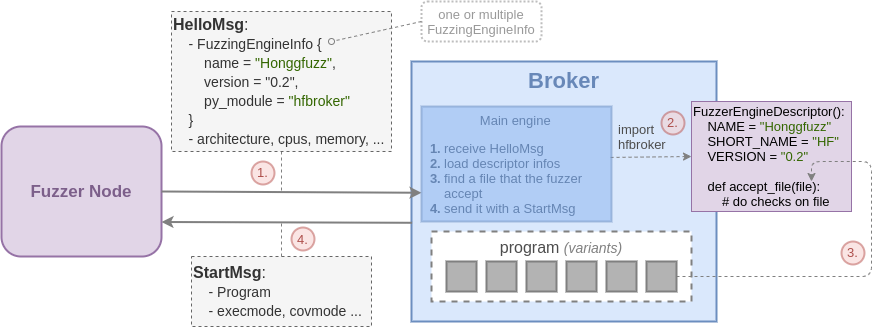Adding a Fuzzer
Prerequisites
To be integrated in PASTIS a fuzzer should support:
receiving new inputs while running
providing input/crashes it generates (preferably as soon as they are produced)
providing some telemetry that could be sent to the broker (current coverage, execution per/sec etc..)
If the fuzzer does not support such features, it first it needs to be modified in order to be compliant. As a matter of example, Honggfuzz does not support such feature and has been modified to periodically read a specific folder for new input files.
Python Driver
Once the fuzzer is ready and satisfies PASTIS constraints, it can be wrapped in a Python driver
that will act as an interface between the fuzzer and the broker. For that, all the required objects
and types have been defined in libpastis. It notably provides a ClientAgent object
(Agent) class that one can inherit from to interact with the broker. The whole purpose
of a driver is to send data generated by the fuzzer to the broker and to react to some messages it
receives from the broker.
A client can send the following message to the broker:
Hello: Indicating its own architecture, number of CPUs, memory, platform and the engines it supports
Seed: To seed an input or a crash it has generated
Data: To seed alert related information to the broker (alert covered or validated)
Log: Logs that seem’s relevant to be sent to the broker
Telemetry: Periodic data about the current state of the fuzzing (exec per/sec, coverage, iterations …)
Conversely, it will receive messages, materialized by callbacks, that will be called and that the driver should implement. The messages are the following:
Start: Message to start a fuzzing campaign. It contains the program, all the runtime configuration parameters that should be used. When receiving such callbacks, the driver should: * check that a campaign is not already running * perform all the initializations * start the underlying fuzzer with the program and appropriate parameters
Seed: Receive a seed from the broker. The driver should forward it to the fuzzer. It can also apply any pre-processing that it considers useful.
Stop: Should stop the campaign
The following snippet shows how to instantiate a basic client agent.
import logging
from typing import List
from libpastis.agent import ClientAgent
from libpastis.types import SeedType, FuzzingEngine, ExecMode, CoverageMode, SeedInjectLoc, CheckMode, LogLevel, State
def start_received(fname: str, binary: bytes, engine: FuzzingEngine, exmode: ExecMode, chkmode: CheckMode,
covmode: CoverageMode, seed_inj: SeedInjectLoc,
engine_args: str, argv: List[str], kl_report: str=None):
pass # commencer la campagne
def seed_received(typ: SeedType, seed: bytes):
logging.info(f"[SEED] { seed.hex()} ({ typ} )")
def stop_received():
logging.info(f"[STOP]")
if __name__ == "__main__":
agent = ClientAgent()
agent.connect() # default is localhost:5555
agent.register_start_callback(start_received)
agent.register_seed_callback(seed_received)
agent.register_stop_callback(stop_received)
agent.start() # start reception thread
agent.send_hello([(FuzzingEngine.TRITON, "v0.8")])
Warning
We recommend inheriting ClientAgent rather than using it a a standalone object.
Broker Addon
The broker is designed to be independent of the fuzzing engine with which it interacts.
Nonetheless, the broker needs to know which program variant to send the fuzzing engine.
Thus, the fuzzing engine should provide a FuzzingEngineDescriptor providing basic
information about the engine and a accept_file(file) method to know whether the file
is suitable for the engine. The broker is then designed with an “add-on” mechanism allowing
to provide the broker with a FuzzingEngineDescriptor object. The following figure summarizes
the handshake process between a client and the broker.

As shown in the figure, when a fuzzer connects to the broker, it should advertise one or multiple
fuzzing engine that it supports with FuzzingEngineInfo (all that is encapsulated in the HelloMsg).
That object also indicates the name
of the python module to side-load on the broker to obtain the FuzzingEngineDescriptor
associated with the engine. The python module should contain a class inheriting FuzzingEngineDescriptor
that describe the engine. (The broker will automatically find the subclass object within the module).
Your fuzzing driver should thus provide this module to be installed on the broker (either as a separate Python module or directly within the main driver code). The object is documented in the API: Fuzzer Interface.
Examples
There is nothing like an example. Thus, one can see existing drivers to see how they are implemented and how they work. They can be used as a basis for other fuzzing engines.
tiny test clients: test_client.py
Honggfuzz driver: driver.py
TritonDSE driver: driver.py